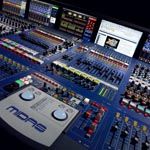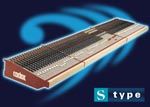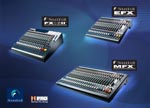- With the abundance of console manufacturers out there, it's hard at times to really gauge where the market's going. While several companies continue to push analog, most have given way to digital consoles as the new force in the market. But what about these consoles are worth the time for a busy contractor, and how can digital consoles help the installation market?
- The demand for consoles has been staggering in the last decade, as Yamaha Commercial Audio's product manager for hardware products, Dan Craik, explained. "The big difference for us is that Yamaha is producing, building, and delivering more consoles now than any time in our history," he said. "Ten years ago our professional line of consoles were analog. We did well with the analog desks back then, but nothing like what we are doing now."
- Yamaha first made the jump into digital eight years ago with the PM1D, which was widely accepted in the market, as Craik recalled. "Interestingly enough, it was the church market that was the first to realize its power and potential, and jumped on it. That started the trend towards digital consoles in sound reinforcement and installed sound. Today, the overwhelming demand is for digital, and 95 percent of our console and sound system product is digital."
- There are a lot of contractors that may shy away from digital consoles because of software turnover or resistance to having to learn a new interface. Robert Scovill, Digidesign's marketing manger for live sound products, commented on the digital console and it's effect on the contractor market: "I'm not sure I see how digital consoles hurt the contractor market other than possibly the concept of short lifespan-whether that hurts them or not. We took a unique slant by making a product line that is a la carte. You can use any console with any I/O box, the software is completely portable. At the end of the day there's the idea of buy early, profit longer."
- Consoles also seem to be getting much more compact. Digidesign's new Profile D Show is an indicator of where the industry is going, however Craik said that engineers won't want to use a microscope to mix sound. "It could easily get down to a GameBoy type controller and a computer. But our experience is that mix operators don't want that. It's still about the tactile controls and console layout. People still want faders and knobs. But who knows? I may have to eat these words a few years from now."
- The most important feature that customers are requesting? Recallibility. "The ability to store mix settings and instantly recall them at will is the primary reason people purchase a digital desk," Craik said.
- The future seems to be one of compromise for consoles. There are still a lot of audiophiles in the industry that cringe when they see a digital console, but the market doesn't lie. "I wouldn't say that all analog consoles will be replaced by digital," Craik said. "There are engineers that prefer analog over digital. But the overwhelming demand at all levels is digital. We see this continuing with many other types of products. When was the last time you bought a film camera or rotary-dial phone? Digital is the way the world has gone. What's in the future for consoles? Networking, and the future is now."
Soundcraft FX Series
The FX16ii, EFX, and MFX each feature no less than 32 Lexicon 24-bit digital effects. The new models use the same AudioDNA processor found in many Lexicon and DigiTech outboard products, including the respected Lexicon MX500. The consoles also boast a user settings store function, three parameter controls, tap tempo, and 32 effects presets. The Spirit FX16 uses the latest 24-bit digital Lexicon effects processor and a new control surface layout. The Soundcraft EFX is the smallest console in the Soundcraft multipurpose range. The MFX is a Soundcraft MPM with built-in Lexicon effects.

Peavey Santuary Series S-32
The Sanctuary Series S-32 features automix, auto delay, and mid-morph EQ. On the S-32, channels 1-24 can be sent to three subgroups, while channels 25-32 have a fourth subgroup option that engages the exclusive automix function. All 32 channels include high, low, mid-frequency, and mid-morph equalization, and all have direct outputs. The stereo line channels simplify patching with three stereo inputs each and dual stereo gain trim controls, and they can accommodate split-accompaniment audio tracks or full stereo playback.

Digidesign D-Show Profile
Digidesign's D-Show Profile mixing console is a size-conscious alternative to the D-Show, the flagship console of the Venue line. It's fully compatible with all existing Venue hardware and software. D-Show Profile takes full advantage of existing Stage and FOH racks, and allows users to connect their VENUE system to Pro Tools|HD and Pro Tools LE systems via an additional hardware option for recording and playback. D-Show and D-Show Profile operate on the same D-Show control software and operating system.

Digico CS-D5
The CS-D5 Live digital mixing system provides the feature set of the D5 Live, with the exception of the optical I/O, creating a D5 Live at a price point that's competitive with more basic consoles. The CSD5's technical advantages include 48 busses, up to 160 input channels, 224 inputs, and 224 outputs. 41 touch sensitive faders, four touch screens, and multi-operator ability give direct instant access to crucial parameters. MADI (standard) and Optocore (optional) interfaces improve versatility and the ability to share stage racks, and eliminates the need for mic splitters.

APB/DynaSonics Spectra Series
The Spectra-C and Spectra-T consoles feature TRS inserts while the Spectra-Ci and Spectra-Ti include balanced insert sends and returns on separate 1/4-inch phone jacks to more easily match the existing wiring schemes of production companies. Each of these VCA-based models is available with 24, 32, 40, 48, and 56 mono input channels and all sizes feature four additional stereo line-input channels. A 24-channel mono-input expander is also available for use with all of the available models for the entire Spectra Series.

Crest Audio CV-20
Crest Audio's CV-20 live-sound mixing console is a flexible VCA audio solution that is available in 24, 32, 40, 48, and 56 mono input configurations with four-band sweepable EQ and parametric mid-frequency control on each mono input. A feature set of 12 aux sends, eight subgroup assignments, and L/C/R panning to the left/right and mono busses is joined by eight stereo input channels consisting of four microphone-line channels and four dual-line channels.
Studer Vista 8
Following the Vista 6 and 7, the Vista 8 similarly incorporates the Vistonics user interface, but this time has extended the concept to provide output metering and control and a host of other features. The Vista 8 combines and extends the broadcast features of the Vista 6 with the automation of the Vista 7 to offer a multipurpose live broadcast desk. The new Control Bay design offers more faders in a smaller footprint, with an additional snapshot system and dedicated mute groups included.

Midas XL8
The Midas XL8 is the first of a new generation of open-architecture, AES-50 cross-platform, integrated audio control, and distribution systems that brings control of not only audio but other aspects of a live performance to a single, intuitive control centre. The XL8's open architecture ensures that both third-party hardware and software (including plug-ins) can be easily integrated into the system.

Yamaha DSP5D
The Yamaha DSP5D, a DSP-expander for the PM5D digital sound reinforcement console, is a stand-alone unit that expands the capabilities of the PM5D to 96 mono plus 16 stereo input channels, includes two additional card slots with more effects and dynamics processing, and can be used with a PC and Yamaha Studio Manager software. When a PM5D is used in conjunction with the new DCU5D Ethernet audio cascade unit and a DSP5D, the DSP5D can be set in a remote location and controlled from the PM5D up to 100 meters using a Cat-5.
Innovason SY48
Offering 48 motorized faders in a small footprint, SY48 is capable of mixing up to 72 inputs simultaneously into 40 mix busses. Thanks to its architecture, which Innovason has called personal console builder, SY48 lends itself to touring or fixed installations at FOH, monitoring or broadcast applications. SY48 is equipped as standard with interfaces that allow simultaneous use of local and remote I/O modules via a single coax, fiber optic, or network Cat-5 cable.

Cadac S-Type Live Production Console
Cadac's compact mixer, the S-Type live production console, is available as 17-, 25-, or 33-way frames, with a typical 25-way frame comprising 16 mono inputs, eight group outputs, aux outputs, matrix outputs, and DC master faders, plus osc/comms module. The S-Type facilities include a mic input plus a full 4-band parametric EQ with the ability to switch the EQ pre the insert point. The S-Type incorporates a balanced direct output with level control, eight switchable post- and pre-fade auxiliary sends, two of which are stereo, a custom-designed stereo input channel with line input, plus metering.










